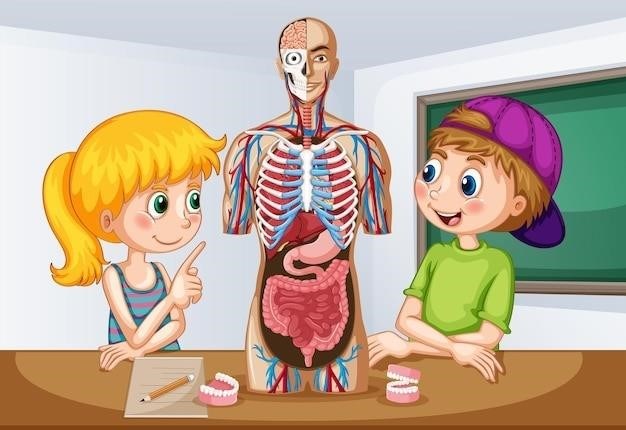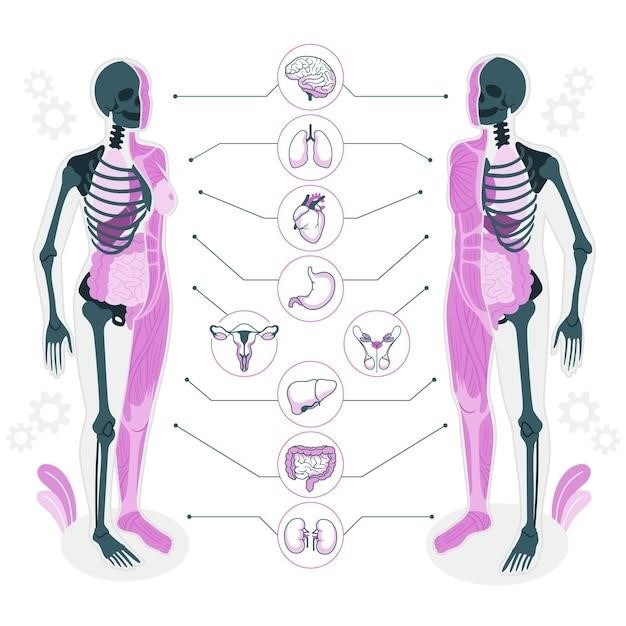
Exploring Anatomy & Physiology in the Laboratory⁚ A Comprehensive Guide
This comprehensive guide delves into the intricacies of anatomy and physiology, offering a hands-on approach through laboratory experiments. It provides a detailed overview of the subject, encompassing safety protocols, basic techniques, and in-depth explorations of various body systems.
Introduction to Anatomy & Physiology
Anatomy and physiology are the fundamental pillars of understanding the human body. Anatomy, the study of structure, explores the intricate arrangement of organs, tissues, and cells, providing a blueprint of our physical form. Physiology, on the other hand, focuses on the functions of these structures, revealing how they work in harmony to sustain life. Together, anatomy and physiology offer a comprehensive understanding of the human body, from the microscopic level of cells to the macroscopic level of organ systems.
This laboratory manual provides a hands-on approach to learning anatomy and physiology, offering a unique opportunity to explore these concepts through practical experiments. By dissecting specimens, examining tissues under a microscope, and conducting physiological investigations, students gain a deeper appreciation for the complexities of the human body. This manual is designed to complement classroom lectures, providing a practical platform for applying theoretical knowledge and fostering a deeper understanding of the subject.
The Importance of Laboratory Experiments
Laboratory experiments are an integral part of learning anatomy and physiology, offering a unique blend of hands-on experience and theoretical knowledge. They provide a tangible connection to the abstract concepts discussed in lectures, transforming theoretical understanding into practical application; Through these experiments, students develop essential skills such as observation, data analysis, and critical thinking, fostering a deeper understanding of the interconnectedness of anatomical structures and physiological functions.
Laboratory experiments also allow for the exploration of physiological processes that are difficult to observe in a classroom setting. Dissecting specimens provides a three-dimensional perspective on anatomical structures, while physiological experiments allow for the study of organ function in real-time. This hands-on approach not only enhances comprehension but also cultivates a sense of wonder and curiosity about the intricacies of the human body.
Safety Guidelines and Procedures
Laboratory safety is paramount in anatomy and physiology courses, ensuring the well-being of students and instructors. Before engaging in any experiment, students must familiarize themselves with the laboratory’s safety protocols and equipment. This includes understanding the location of safety equipment such as fire extinguishers, eye wash stations, and first aid kits. Students should also be aware of proper handling procedures for chemicals, biological specimens, and sharp instruments.
Proper attire is crucial, with lab coats, gloves, and safety goggles being mandatory for certain experiments. Students should always follow the instructions provided by their instructors and never conduct experiments without proper supervision. This includes adhering to the specified safety guidelines, handling specimens with care, and disposing of waste materials appropriately. By prioritizing safety, students can create a secure learning environment conducive to scientific exploration and discovery.
Basic Laboratory Techniques
Mastering basic laboratory techniques is essential for successful exploration in anatomy and physiology. These techniques form the foundation for conducting experiments, analyzing data, and drawing meaningful conclusions. One fundamental skill is precise measurement, involving the use of tools such as graduated cylinders, pipettes, and balances. Students must learn to accurately measure volumes and masses to ensure the reliability of their experimental results.
Dissection, a core technique in anatomy, requires meticulous handling of specimens and precise identification of anatomical structures. Students must develop dexterity and a keen eye for detail to effectively dissect and analyze the intricate components of the human body. Additionally, microscopy is an indispensable tool for observing cellular structures and tissues, enabling students to visualize the microscopic world that underpins physiological processes. By mastering these basic techniques, students gain the skills necessary to conduct rigorous scientific investigations and deepen their understanding of the human body.
Microscopy and Cell Observation
Microscopy plays a pivotal role in anatomy and physiology labs, providing a window into the microscopic world of cells and tissues. Students delve into the intricacies of light microscopy, learning to prepare slides, focus on specimens, and interpret images. This technique allows them to observe the fundamental building blocks of life – cells – and their intricate structures, including the nucleus, cytoplasm, and organelles. Beyond basic observation, students gain experience with specialized techniques like staining, which enhances the visibility of specific cellular components.
Through microscopy, students gain a deeper appreciation for the complexity of biological systems, understanding how the structure and function of cells contribute to the overall health and well-being of the organism. This hands-on experience fosters a deeper understanding of the interconnectedness of life at the cellular level, reinforcing the importance of microscopic processes in maintaining overall physiological balance.

Histology⁚ Exploring Tissues
Histology, the study of tissues, takes center stage in anatomy and physiology labs, providing students with a deeper understanding of how cells work together to form functional units. Through microscopic examination of prepared slides, students explore the diverse array of tissues that make up the human body, gaining insights into their unique structures and functions. They learn to identify the four primary tissue types⁚ epithelial, connective, muscle, and nervous, recognizing their distinct characteristics and roles in maintaining bodily functions.
Students delve into the intricate details of epithelial tissues, appreciating their roles in covering surfaces, lining cavities, and forming glands. They investigate the diverse forms of connective tissues, gaining an understanding of their supportive, protective, and binding functions. Further exploration delves into the fascinating world of muscle tissues, recognizing their ability to generate movement and maintain posture. Finally, students unravel the complexities of nervous tissues, appreciating their crucial role in communication, coordination, and control within the body.
The Skeletal System⁚ Structure and Function
The skeletal system, a marvel of engineering, provides the framework for the human body, offering support, protection, and enabling movement. Anatomy and physiology labs provide an immersive experience in exploring this intricate system, delving into the structure and function of bones, joints, and cartilages. Students engage in hands-on activities, examining real or model bones, identifying key anatomical landmarks, and understanding their unique contributions to the skeletal framework. They learn about the different types of bones, from the long bones of the limbs to the flat bones of the skull, appreciating their diverse shapes and functions.
Labs often involve studying the different types of joints, exploring their range of motion, and understanding how they facilitate movement. Students learn about the vital role of cartilage in providing cushioning and reducing friction at joint surfaces. These practical experiences provide a tangible understanding of the skeletal system’s crucial role in supporting the body, protecting vital organs, and enabling a wide range of movements, from walking and running to the delicate movements of the fingers.
The Muscular System⁚ Movement and Locomotion
The muscular system is the powerhouse of the body, responsible for generating movement, maintaining posture, and facilitating a multitude of bodily functions. Anatomy and physiology labs offer an interactive exploration of this dynamic system, providing students with a hands-on understanding of muscle structure, function, and their interplay in locomotion. Students delve into the microscopic world of muscle fibers, examining their unique structure and arrangement, and how these features contribute to their contractile properties. They learn about the different types of muscle tissue, from the voluntary skeletal muscles that control movement to the involuntary smooth muscles that regulate internal organ functions.
Through practical exercises, students analyze muscle contractions, exploring the interplay of actin and myosin filaments and the role of calcium ions in triggering muscle contraction. They dissect animal models or study anatomical models to visualize the intricate arrangement of muscles and their attachments to bones; These labs provide a comprehensive understanding of how muscles generate force, enable movement, and contribute to the body’s overall functionality, from the coordinated movements of walking and running to the subtle actions of facial expressions.
The Nervous System⁚ Control and Coordination
The nervous system, the body’s intricate communication network, is a fascinating subject of study in anatomy and physiology labs. These labs provide a hands-on exploration of the central and peripheral nervous systems, dissecting the complexities of neural structure, function, and their role in coordinating bodily activities. Students delve into the microscopic world of neurons, examining their unique structure, including the cell body, dendrites, and axon, and their role in transmitting electrical impulses. They learn about the different types of neurons, including sensory neurons that receive stimuli from the environment, motor neurons that transmit signals to muscles, and interneurons that connect different neurons within the nervous system.
Practical exercises involve studying the structure of the brain and spinal cord through dissections or anatomical models, identifying key regions and their associated functions. Students explore reflexes, the body’s automatic responses to stimuli, by conducting experiments that demonstrate the neural pathways involved in reflexes like the knee-jerk reflex. These labs provide a comprehensive understanding of how the nervous system receives sensory information, processes it, and generates appropriate motor responses, enabling the body to react to its environment, control movement, and maintain homeostasis.
The Cardiovascular System⁚ Circulation and Transport
The cardiovascular system lab experience delves into the fascinating world of the heart, blood vessels, and blood, exploring their vital roles in transporting oxygen, nutrients, and waste products throughout the body. Students gain hands-on experience dissecting animal hearts, identifying chambers, valves, and major blood vessels, and understanding the intricate mechanisms of blood flow through the circulatory system. They learn about the different types of blood vessels, including arteries, veins, and capillaries, and their structural adaptations for efficient transport.
Experiments involving blood pressure measurements, pulse rate monitoring, and electrocardiogram (ECG) interpretation provide insights into the dynamic functioning of the heart and its electrical activity. Students explore the composition of blood, identifying red blood cells, white blood cells, and platelets, and understanding their specific functions in oxygen transport, immune defense, and blood clotting. These laboratory activities foster a deep understanding of how the cardiovascular system ensures the continuous delivery of essential substances to every cell in the body, maintaining homeostasis and supporting overall health.